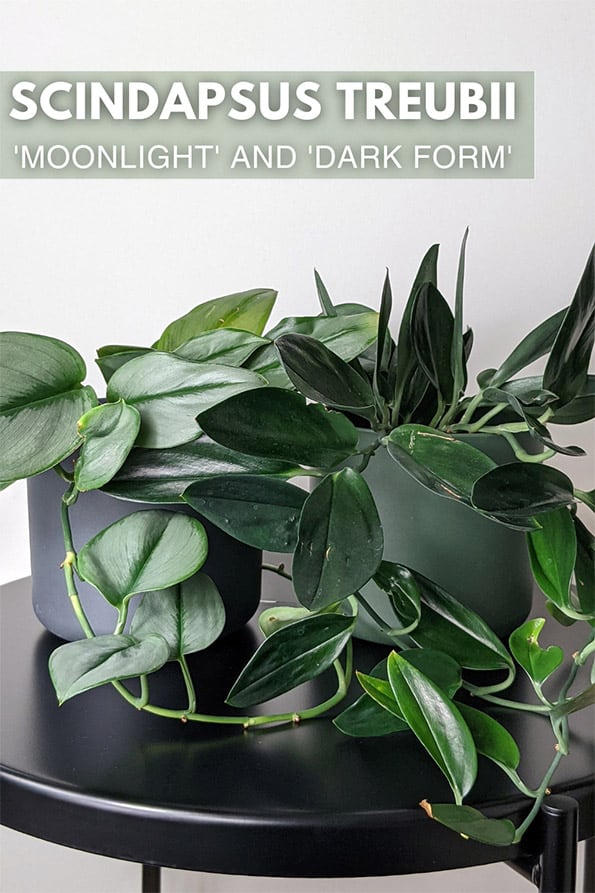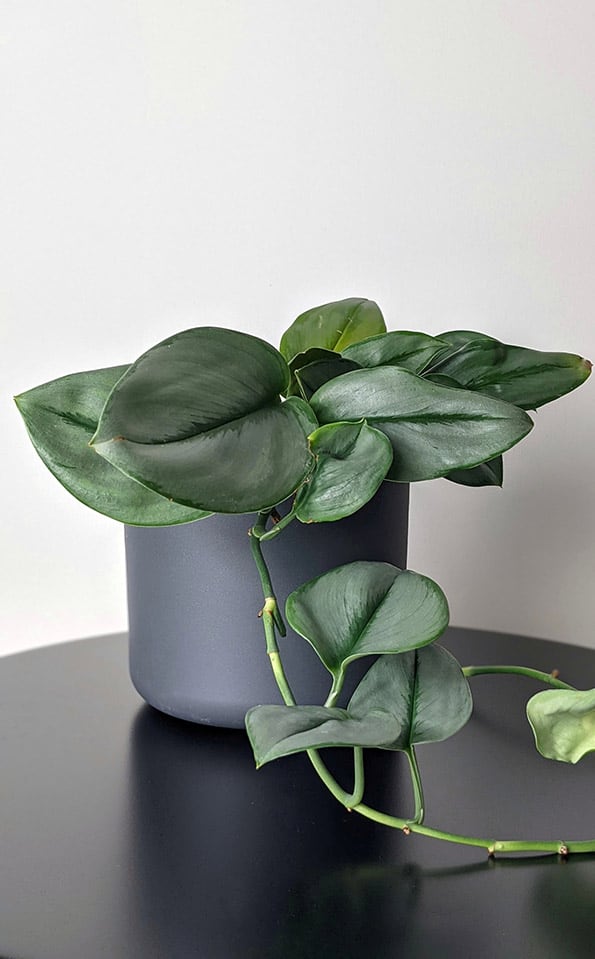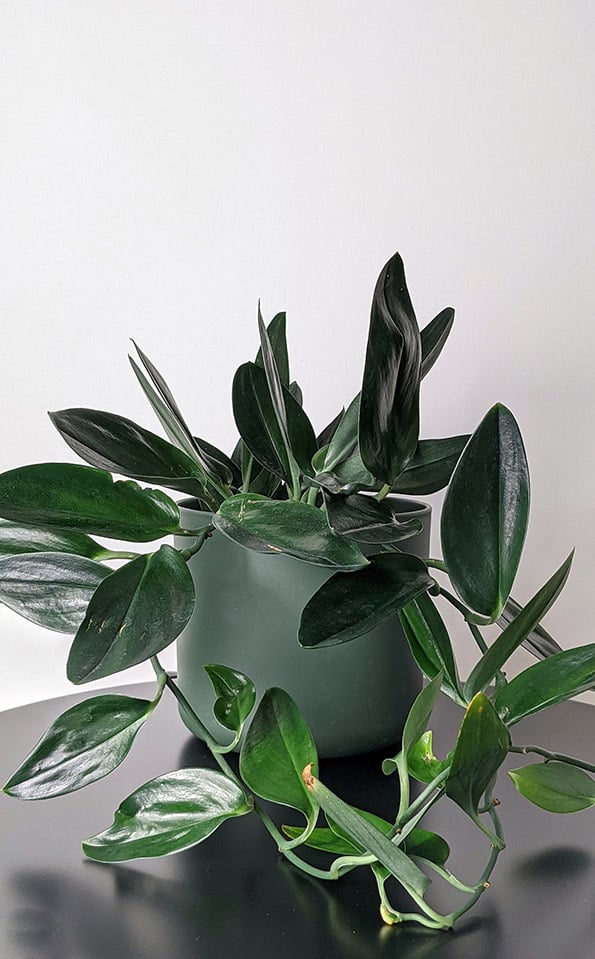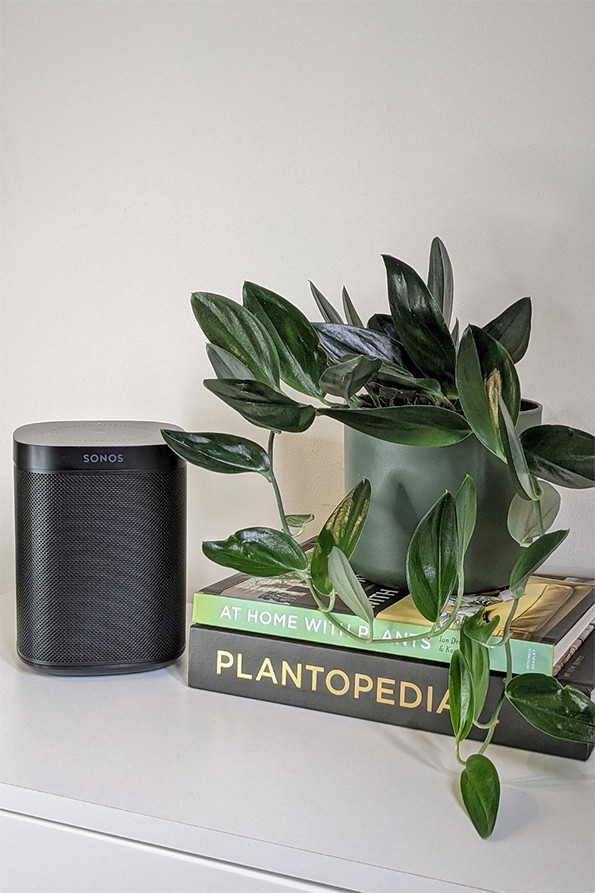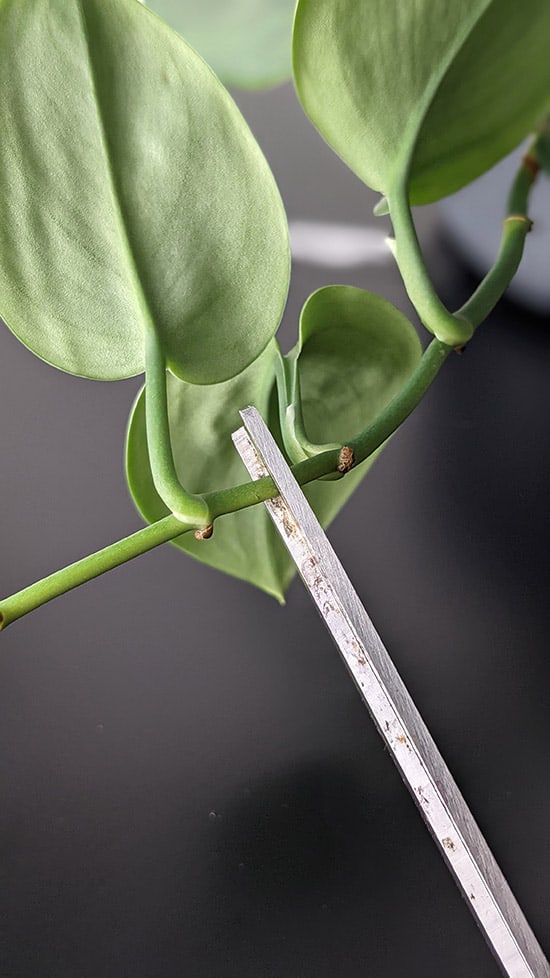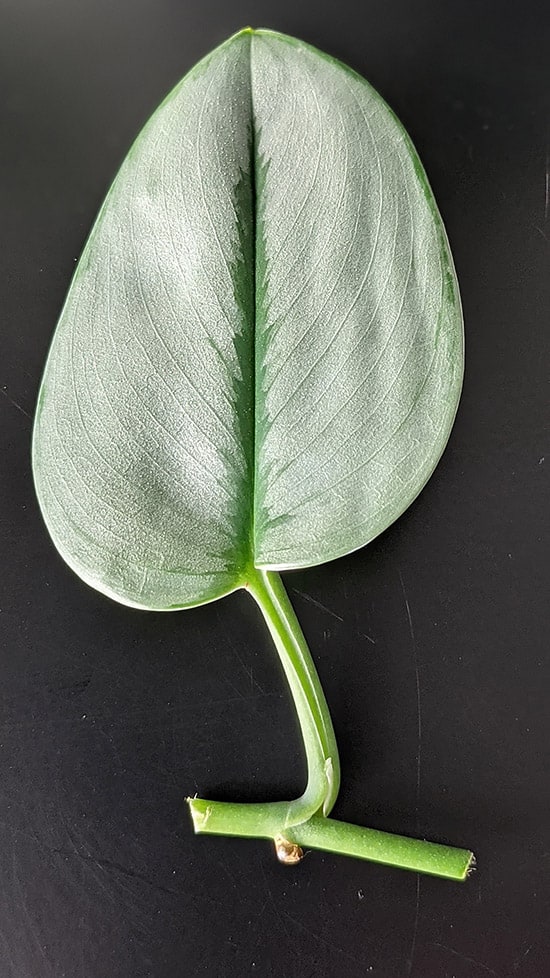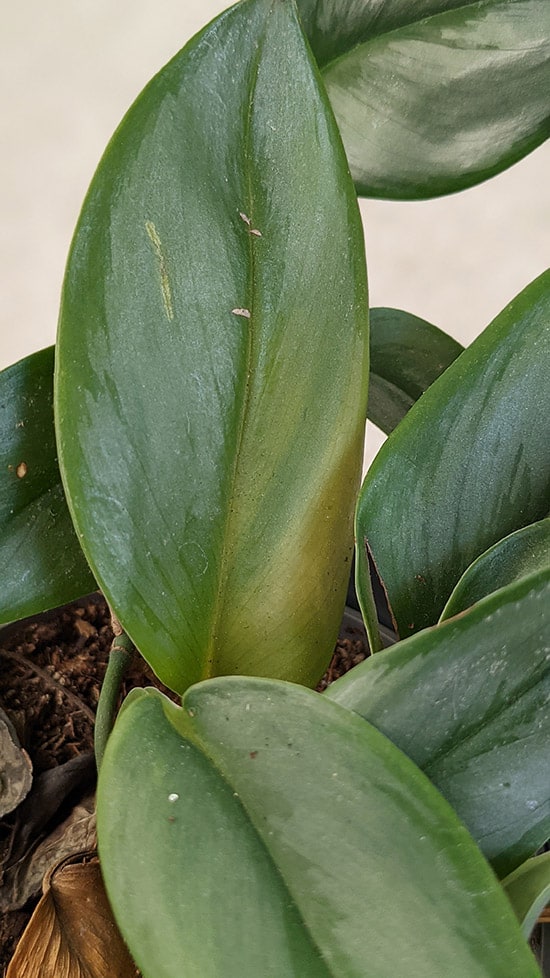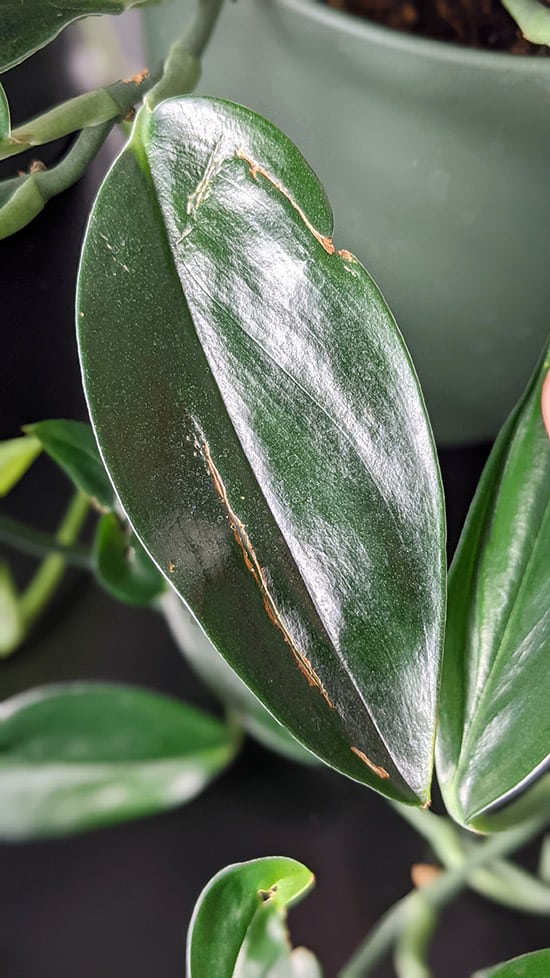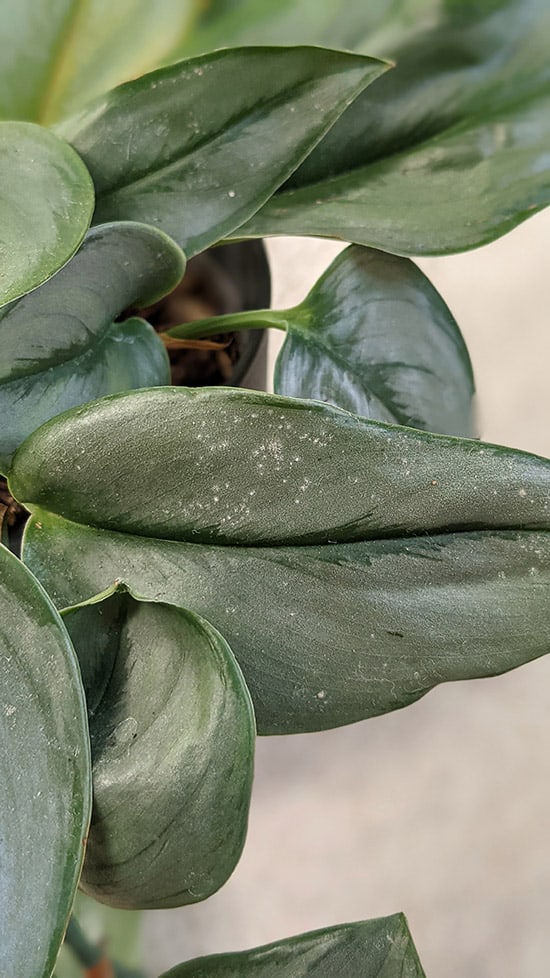If you like unusual tropical plants that have elegance with a wild nature, then the Scindapsus Treubii could be an ideal houseplant.
The care needs are fairly straightforward, but this indoor plant has some drawbacks that mean it's not for everyone. I'll cover those later, but if you're a fan of this rare plant, it has much going for it.
The Scindapsus treubii 'Moonlight' plant on the left and Scindapsus treubii 'Dark form' on the right are from the aroid family. Both are classed as a climbing plant, but they're also happy to trail like this.
The plants are very similar to Pothos, but the leaves in both types are a little thicker and a little more robust. They can be trained to cover a moss pole or allowed to trail downwards.
Like Pothos, they're pretty adaptable plants regarding light levels, and in some ways, I've found they have a slightly better disposition as indoor plants. Being less likely to drop leaves means I'd rank them as an excellent low-maintenance plant.
Additionally, growth tends to be relatively compact, so it's easy to have a full looking plant without too much work.
How do you pronounce Scindapsus treubii correctly? Say: Sin-Dap-Cis tru-be-eye
So what are these drawbacks I've mentioned?
Well, unlike the more familiar Pothos, Scindapsus treubii is a very slow grower. Like snails, pace slow. They can become large plants over several years, but those single-leaf cuttings will be tiny for a good while.
Common Names
Most people will call them by their "Moonlight" and "Dark Form" marketing names.
Variations on this are common, i.e. "Moonlight Pothos" and a second marketing name of "Sterling Silver" is also used.
With that in mind you might be better off just buying a larger one to get that immediate impact and that's where the second problem comes into play.
They're still considered "rare" or unusual houseplants and have limited availability. For us, the buyers, this means they're easily double or triple the price of a similar sizes Pothos.
If you've read through my introduction to these houseplants, you'll already know two varieties are on offer. And there are only two (so far), excluding a couple of variegated versions.
This makes it a bit easier if you 1) have the "Gotta Catch 'Em All" mentality and 2) Don't like too much choice and trying to work out which is "best".
I've also mentioned that Scindapsus treubii can be expensive and reasonably uncommon, so it may be tricky to find.
I own both of these plants and can confirm that the care requirements of the two plants are almost identical. But there are some subtle differences which I will cover in my care guide a bit later.
This variety has a silvery sheen on the heart-shaped leaves. The narrow central area and outer parts of the foliage are a darker green, so there is a lovely eye-pleasing contrast.
The spaces between the nodes on the stems are pretty short too, so it looks like a "full" and bushy plant even when quite small.
Moonlight Scindapsus, also known as the sterling silver Scindapsus, is a showy foliage plant that can fit into most homes and houseplant collections.
There are definitely similarities to the Satin Pothos (Scindapsus Pictus), so I totally get why the Moonlight was the first Treubii variety that started to be sold as a houseplant. It's beautiful.
Because it had a head start, there should be more of these plants around, more sellers selling them and compared with the Dark Form, it's usually more available and slightly cheaper.
The Dark Form came out later and it was incredibly rare in the beginning. So rare, in fact, it had asking prices that were three figures. Today it's much closer in price to the Moonlight.
And this reduction is very welcome, because I think the Dark Form is amazing and it's a great houseplant, now at a more affordable price for anyone who wants it.
On healthy plants, the juvenile leaves of S. treubii Dark Form will start out as lighter green, but they'll quickly darker up and look almost black in the right light.
The glossy leaves are narrow and very dark green. In the picture above I'm using a strong light to take a decent photo, and this is giving the green a lighter appearance, but in everyday light, the leaves look almost black.
Again the nodes on the stem are close together but the leaf petiole (stalk) that attaches to the main stem is slightly smaller and holds itself at sharper angles. This gives the plant a very structural and unusual look.
In the photo above you can see it's creating a strong curve that draws the eye. In comparison, the Moonlight variety has a softer and flatter appearance.

Hi, I'm Tom!
If you're like me and enjoy the challenge of growing houseplants and getting them to thrive, then Ourhouseplants can help. This website shares my knowledge and years of growing plants and provides (hopefully) helpful advice on properly caring for your indoor plant friends.
The Dark Form can cope with a slightly darker spot than the Moonlight. Neither want very strong direct sunlight during the most intense parts of the day, so keep them away from it to prevent damage occurring to the leaves.
Bright indirect light is the go to. But actually I've found they're usually fine in Morning and late afternoon direct sunshine, so sitting them in East and West facing windows are usually good spots.
Pothos plants are well known for being able to deal with some very low light levels, but Scindapsus Treubii needs more light.
If you keep it somewhere too dark, the vines will stop producing new leaves and instead grow long bare stems that creep towards the nearest light source.
How frequently do I need to water?
Always hard to answer this one because I don't have all the details of your unique growing conditions.
Follow the general guidance. Water when the potting
medium has almost fully dried out.
As an example for me and my plants. This tends to happen once a week during the Summer and perhaps every two or three weeks in Winter.
Do be careful with watering these houseplants. They really struggle with excessive amounts of water around their roots. Root rot is probably their main weakness; if it sets in, you'll likely lose your plant.
Always play it safe and let most of the potting medium dry out before you water it again.
You can help this happen by avoiding peat moss based potting mediums and going for more coarse and open mixes (more on this later).
As with almost all indoor plants, they're going to use less water in the colder months of the year and whenever there is less light around. This could be over the Winter months, or if you've picked a lower light location for it (not recommended anyway because they do prefer medium to higher light levels for proper growth).
Scindapsus treubii is native to Indonesia, Borneo and parts of Malaysia that have jungles and rainforests. These places are very humid so essentially you would be correct to say that they prefer high humidity levels.
But, they're actually adapted to dealing with variable levels of humidity.
The common brown tips that houseplants tend to get are reasonably uncommon for Scindapsus Treubii. So unless your humidity levels are very low, your plant will likely be perfectly fine with no additional support. No need to break out that misting bottle or pebble tray! (they don't really work on houseplants anyway).
Scindapsus treubii doesn't need high amounts of fertilizer. Growth is slow with these plants no matter what you're doing, and giving higher amounts or more regular feeds doesn't make them grow any faster (I know this because I've tried it!).
So I keep it simple and feed my plants every few months with a regular houseplant feed.
Coming from the tropical jungles and rainforests of southeast Asia trying to grow them in ordinary rooms might seem impossible. But actually, they adapt very well and can thrive as indoor plants.
They can cope with a broad range of temperatures but will only grow when the daytime temperatures are reasonably high. Upwards of 21°C (70°F) is generally needed. In their native habitat, day temperatures often reach close to 32°C (90°F).
Average temperatures are "fine" but the plant will produce very little (or no) growth in these temperatures. As you might already have guessed these are warm loving houseplants and they don't like anything below 10°C (50°F).
New foliage is slow to grow and this also goes for the roots. Everything is slow with these houseplants. You might get away with just repotting your plants every three or four years.
Young plants in very small containers will need more frequent repotting.
As covered already, watering mistakes can cause big issues. So using free draining and open potting mixes is going to help prevent this. Aroid mixes are suitable as are most other substrates such as coco coir.
If you do opt for something more compact and dense, open it up by adding in larger particles that don't hold water, like perlite, vermiculite, orchid bark etc.
Watch my YouTube Video for more visuals showcasing aspects of this plant that I couldn't capture in photos
If you want more plants and are not in a hurry to get them, you can save money by propagating them at home.
Like most vining plants, you can easily take stem cuttings. Put them in a jar of water, soil, sphagnum moss or even LECA and all being well in a month you will have a root network forming.
Most scindapsus plants can be propagated through stem cuttings like this. All you need to do is cut the slow-growing vine between two nodes, as seen here.
To take stem cuttings have a look at the stem / vine that all the leaves are coming from. You'll see small brown dot like marks every inch or so, most of them will have a leaf on the other side. These are called "nodes".
All you need to do is cut the stem between two nodes. Ensuring the node has a healthy leaf. When put into water, soil, or LECA, the node should activate and the leaf will generate energy that allows a root network to start growing.
This is all you need to create a brand new plant. Put the cutting into a vase of tap water, or plant directly into a small container holding fresh well-draining soil.
There is a reasonably high success rate with stem cuttings. Do it when the day temperatures are on the warmer side (late Spring, or Summer) and put the cutting near a window so it gets good light.
Grow several cuttings in the same container.
The stems rarely split or branch, so a single long trailing vine might not be something you want looks wise.
Instead, if you like a bushy and full looking plant, once the cuttings are established, with roots put two or three cuttings into one pot for an instant effect.
You can do it at other points of the year, but I've personally found that although the cuttings often root, they seem to run out of poke after a few months and fail. I need to experiment more but I think the night temperatures are too low for it.
Feel free to share your method in the comments below if you've propagated yours.
The Dark Form variety was considerably rarer initially (at least in my part of the world) and in the early days it was common to see people speculating that this was because the Dark Form was slower growing and so harder for growers to propagate it.
After growing mine for several years, I will say that speculation was rubbish.
What really happened was that the Moonlight was considered to be more attractive and on trend with variegated plants at that time when it came to market. The growers assumed people would like it more, so mass produced it over the Dark Form.
Turns out that Scindapsus Treubii Dark Form actually growers faster than the Moonlight. I'm doing the speculating now, but I suspect that the reason for this is that there is much more chlorophyll in the leaves. It's simply better at trapping light energy and can generate more growth as a result.
It's not you. Don't worry.
I've had barely any growth in the couple of years I've owned my plants. I've never heard anyone who says differently or says this is a fast-growing houseplant.
That said listen up when I say, the Dark Form might be faster growing, but only in direct comparison with the Moonlight. These plants when compared with other houseplants are slow growers. Painfully slow. You might only get a handful of new leaves over an entire growing season.
Each vine can grow to impressive lengths or 6 feet or more. Just don't expect it to happen quickly.
They can be allowed to trail around, or you can wrap them. You can also grow them up grow sticks. They don't produce many aerial roots, so at the start you may need to tie them to the grow support until they get going.
Flowering is rare, but a flower can appear now and again. If this happens, you will get a white or cream spadix surrounded by a cream colored "hood" or spathe.
This will last a month or so. You can leave it alone or remove it at any point without harming the plant.
No Growth.
Slow growth is to be expected, but if your plant's not grown at all for a long period, then it's probably going to be down to one of the following reasons.
Yellow Leaves.
These plants hold on to their leaves well, so yellow foliage is not usually common. For example, my plants only have the odd yellow leaf now and again.
The handsome silver variegation being replaced by yellow. Always disappointing to see, but hopefully it's not a sign of a bigger problem brewing.
If you do have yellow leaves then it's likely to be caused by one of the following.
Damaged Leaves.
Because they're trailing plants, it's normal for the leaves to be knocked or bashed over time. They're not replaced very often so do try and prevent this from happening to maintain the attractive look.
This is a slow growing plant (I think you know this by now!), so the leaves can be kept for years and years. This is a long period where they can be knocked about and damaged like in the photo above which builds up.
Try and keep it away from high footfall locations to help prevent this.
White Mold.
Average household humidity is usually fine, but if you tuck your plant away in a corner with poor ventilation, mold can grow on the leaves. It's unsightly but easy to wipe off,
Another problem with the leaves not being renewed frequently is that leaves can become dust magnets and also in higher humidity locations with poor ventilation, mold can actually grow on the leaf surface.
This isn't a problem with the plant itself but the growing environment. The best way to try and stop this happening is to clean the leaves of dust and debris every 6 months or so.
Strictly speaking no they're not safe around plants. The leaves and stems contain small amounts of calcium oxalate crystals that can give a painful and swollen mouth to anything or anyone that tries to eat it.
If you are comparing it with other Scindapsus varieties that you can find in big box stores and plant nurseries then yes absolutely the treubii is rare. Although the Moonlight and the Dark Form are thought of as rare plants, they're easy to find online from places like eBay and Etsy, which isn't usually the case for truly rare houseplants.
Let's call them unusual, leaning towards specialist.
It's hardy in terms of care. They're not divas or extremely fussy about anything other than cold temperatures and overwatering (they don't like either of these things).
Almost certainly caused by not giving it enough light. When the stems grow with few leaves forming, it's seeking out a brighter spot.
They're easy enough houseplants. You do need to be extra careful not to overwater, but otherwise, they're pretty robust and straightforward to own.
